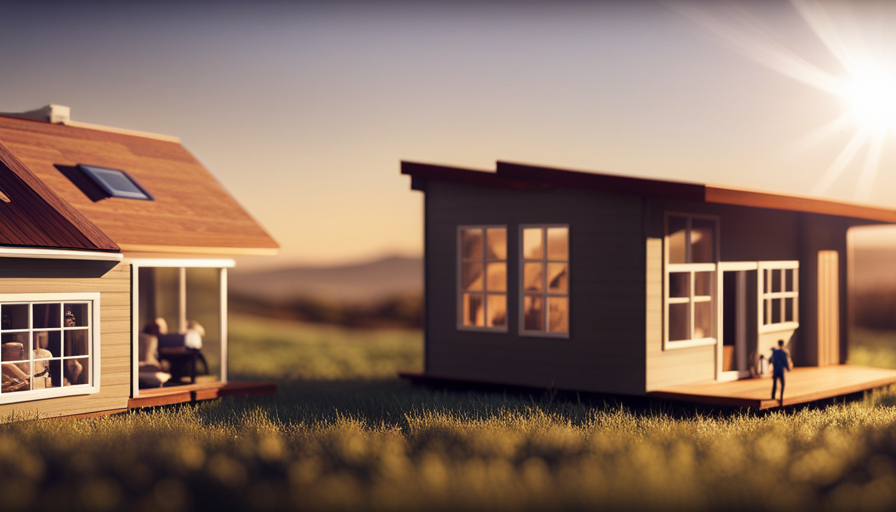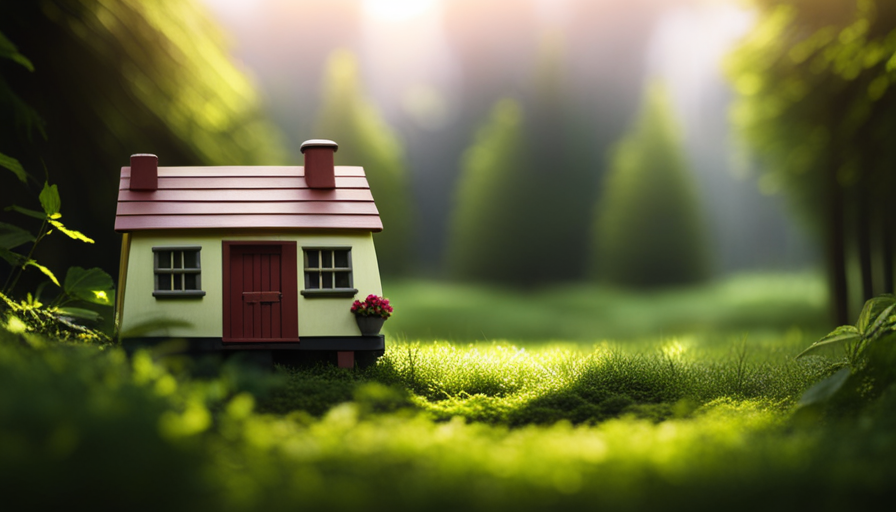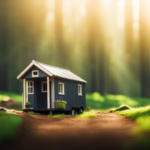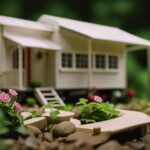In real estate, the saying “A penny saved is a penny earned” holds true, highlighting the financial implications. As a result, more people are exploring the idea of tiny houses as a budget-friendly alternative to traditional housing.
But the question remains: Is it cheaper to build a tiny house or buy one? In this article, I will delve into the nitty-gritty details and provide you with a comprehensive analysis of the costs involved in both options.
From assessing your budget and skills to researching the market for pre-built tiny houses, we will explore all the necessary factors to help you make an informed decision.
So, if you’re ready to embark on this financial journey and find the most cost-effective solution for your housing needs, let’s dive in and discover whether building or buying a tiny house is the way to go.
Key Takeaways
- Building a tiny house allows for more control over budget and materials.
- Buying a pre-built tiny house eliminates construction time but may have a higher upfront cost.
- Building a tiny house allows for customization and cost-effectiveness in the long run.
- Buying a pre-built tiny house offers convenience and immediate occupancy.
Consider Your Budget and Financial Goals
If you’re dreaming of financial freedom and want to stretch your budget as far as possible, it’s essential to consider whether it’s cheaper to build or buy a tiny house.
Building a tiny house allows you to have more control over your budget constraints and financial sustainability. You can carefully choose materials and finishes that fit within your financial limits, and even opt for reclaimed or repurposed items to save costs. Additionally, building your own tiny house gives you the opportunity to utilize your skills and resources effectively, potentially reducing labor and construction costs.
However, it’s important to note that building a tiny house requires a significant amount of time, effort, and knowledge. If you’re not confident in your construction abilities or don’t have the necessary resources, it might be more cost-effective to buy a pre-built tiny house.
Assessing your skills and resources will help you make an informed decision on the most affordable option for you.
Assess Your Skills and Resources
You’ll need to evaluate your abilities and available resources to determine the most cost-effective option. Remember, “Where there’s a will, there’s a way.”
When assessing your skills and resources, consider the following:
- Evaluate your carpentry skills: Can you confidently handle tasks such as framing, roofing, and electrical work?
- Assess your available tools: Do you have the necessary tools to complete the project?
- Calculate your time commitment: Do you have the patience and dedication to see the project through to completion?
- Consider your support network: Do you have friends or family members who can assist you with the construction process?
By evaluating your capabilities and available tools, you can determine if building a tiny house is a feasible option for you.
Next, we will explore the cost of building a tiny house.
Research the Cost of Building a Tiny House
Discover how affordable it can be to create your own compact dream home by researching the costs of constructing a pint-sized dwelling. When considering whether to build or buy a tiny house, conducting a cost comparison is essential.
Begin by researching the expense of materials, permits, and labor for the construction process. Calculate the costs for the foundation, framing, insulation, plumbing, electrical systems, and interior finishes. Don’t forget to include any additional expenses, such as hiring professionals or purchasing specialized tools. By thoroughly examining the potential costs, you can determine if building a tiny house is a more cost-effective option for you.
Once you have gathered all the necessary information, you can then explore the market for pre-built tiny houses, comparing the prices and features. This will allow you to make an informed decision on the most budget-friendly approach to achieving your tiny house dreams.
Explore the Market for Pre-Built Tiny Houses
When it comes to finding a ready-made compact dwelling, you’ll be pleasantly surprised by the variety and charm available in the market for pre-built tiny houses. There are numerous pre-built tiny house options to choose from, ranging in size, design, and price.
Buying a pre-built tiny house offers several advantages. Firstly, you can save time and effort by skipping the lengthy construction process. Additionally, pre-built tiny houses often come with warranties, ensuring peace of mind and protection against unexpected issues. Furthermore, buying a pre-built tiny house allows you to see the final product before making a purchase, ensuring that it meets your needs and preferences.
With such a wide selection available, you can easily find a pre-built tiny house that suits your budget and style.
Transitioning into the next section, let’s now compare the pros and cons of building versus buying to determine the most cost-effective option.
Compare the Pros and Cons of Building vs Buying
There are advantages and drawbacks to both constructing and purchasing a compact dwelling. When it comes to budget comparison, building a tiny house can be cheaper, as you have control over the materials and labor costs. You can choose affordable options and even repurpose materials to save money.
On the other hand, buying a pre-built tiny house may have a higher upfront cost, but it eliminates the need for construction time and additional expenses.
In terms of quality comparison, building a tiny house allows you to ensure that every aspect meets your standards. You can personally oversee the construction process and make sure that the materials used are of high quality.
However, buying a pre-built tiny house means relying on the expertise of professionals who have experience in designing and constructing these homes.
When considering whether to build or buy, it is important to factor in additional costs and considerations such as land, permits, and maintenance.
Factor in Additional Costs and Considerations
To fully evaluate the financial implications and practical aspects of your decision, it’s crucial to thoroughly assess the additional expenses and considerations involved in building or buying a tiny house.
Aside from the actual cost of the house, there are several hidden costs that need to be factored in. One major expense is acquiring suitable land, which can vary greatly in price depending on location. Additionally, obtaining necessary permits can be another unexpected cost, as well as ensuring regular maintenance and repairs.
It’s important to carefully budget for these additional expenses to avoid any financial surprises down the road. By considering all of these factors, you can make a more informed decision about whether building or buying a tiny house is the more cost-effective option.
Evaluating the time and effort involved in building will be the next step in determining the best choice for you.
Evaluate the Time and Effort Involved in Building
Assessing the time and effort involved in constructing a tiny home can help determine if it is the right choice for you. Building a tiny house requires a significant time commitment and a range of skills. From researching the building process to seeking advice and available resources, there are many steps involved in the construction. It is important to evaluate your personal preferences and consider the pros and cons of building versus buying. Additionally, careful budget planning is necessary to understand the financial implications of building a tiny home. It is crucial to consider the long-term implications and whether the time and effort invested in building will align with your future plans and flexibility. Transitioning into the subsequent section, it is essential to consider your long-term plans and flexibility when making an informed decision.
Consider Your Long-Term Plans and Flexibility
When deciding on a tiny home, it’s important to think about your long-term plans and how much flexibility you’ll need.
Building a tiny house allows for greater personalization and customization, as you have complete control over the design and layout. This can be a major advantage for those who have specific preferences or unique needs. Additionally, building your own tiny house can be a cost-effective option in the long run. While it may require more time and effort upfront, the long-term benefits can outweigh the initial investment.
On the other hand, buying a pre-built tiny house offers convenience and immediate occupancy. It eliminates the need for extensive planning and construction, which can be especially appealing for those who prioritize convenience over personalization.
Consider your priorities carefully when deciding between personalization and convenience for your long-term plans. Transitioning to seeking advice and learning from others’ experiences can provide valuable insights in making an informed decision.
Seek Advice and Learn from Others’ Experiences
Gaining insights from others who’ve already embarked on the journey of creating their own compact living spaces can be incredibly valuable. Speaking to tiny house owners and seeking their advice can provide you with a wealth of knowledge and cost-saving strategies. They can share their experiences and offer tips on where to find affordable materials, as well as recommend reliable and budget-friendly contractors or builders.
Additionally, joining online forums or attending tiny house meetups can connect you with a community of like-minded individuals who can offer support and guidance throughout your own tiny house journey. By learning from others’ experiences, you can avoid common pitfalls, save money, and make informed decisions. This will ultimately help you make an informed decision based on your needs and preferences.
Make an Informed Decision Based on Your Needs and Preferences
Considering your unique lifestyle and preferences, it’s important to carefully weigh your options and choose the perfect compact living solution for you. When deciding between building a tiny house or buying one, there are a few key factors to consider. First, budget considerations play a significant role. Building a tiny house allows for more control over costs, as you can choose materials and features that align with your budget. On the other hand, buying a pre-built tiny house may have a higher upfront cost but can save you time and effort. Additionally, personalization options should be taken into account. Building a tiny house gives you the freedom to customize every aspect, from layout to design, while buying one may limit your choices. Ultimately, it’s essential to evaluate your financial situation and desired level of personalization before making a decision.
| Pros of Building a Tiny House | Pros of Buying a Tiny House |
|---|---|
| Complete control over design | Time and effort savings |
| Flexibility in material choices | Potential for better quality |
| Potential cost savings | Larger selection available |
| Opportunity for personalization | Immediate move-in ready |
| Satisfaction of building your own home | Easier financing options |
Frequently Asked Questions
How much does it cost to build a tiny house on average?
The average cost to build a tiny house is around $25,000 to $35,000. However, don’t be deterred by the price tag. When considering the cost comparison, building a tiny house can actually be more cost-effective in the long run.
By customizing your own space and utilizing affordable materials, you can save money on both construction and maintenance. Plus, you’ll have the satisfaction of creating a unique and personalized home that perfectly fits your needs.
Are there any financing options available for building a tiny house?
Tiny house financing options can make building a tiny house more affordable. While the cost of building a tiny house can vary, financing options like personal loans, RV loans, and construction loans can help cover the expenses.
The pros of building a tiny house include customization and potentially lower costs, while the cons include the need for construction skills and time investment. Buying a tiny house may offer convenience, but it can be more expensive.
Can I customize the design and layout of a pre-built tiny house?
Yes, pre-built tiny houses do offer customization options and interior layout flexibility. Many companies allow you to choose from a range of floor plans, finishes, and fixtures to suit your preferences. You can often customize the design and layout to maximize space efficiency and functionality. However, it’s important to be mindful of the additional costs that may come with customization, as they can significantly impact the overall price of the pre-built tiny house.
Are there any zoning regulations or restrictions for building a tiny house?
Navigating zoning regulations and restrictions for building a tiny house can be a bit like trying to find a needle in a haystack. You’ll need to consider local ordinances, setback requirements, and building codes.
Additionally, finding suitable land can pose challenges, as some areas may have limitations on where tiny houses can be placed. It’s crucial to do thorough research and consult with local authorities to ensure compliance and avoid potential roadblocks in your tiny house journey.
What are the maintenance and upkeep costs associated with owning a tiny house?
When it comes to the maintenance and upkeep costs of owning a tiny house, there are a few factors to consider.
Firstly, regular maintenance tasks such as cleaning, painting, and inspecting the structure are necessary to keep the house in good condition.
Additionally, you’ll need to budget for utilities, such as electricity, water, and waste disposal.
Other potential costs include repairs, insurance, and any necessary upgrades or renovations.
Despite these expenses, owning a tiny house can still offer long-term savings compared to traditional larger homes.
Conclusion
After thoroughly researching and considering both options, I’ve come to the conclusion that building a tiny house can be a more cost-effective choice. While buying a pre-built tiny house offers convenience, building one allows for customization and potential savings.
By carefully assessing your budget, skills, and resources, you can control the cost of materials and labor. Additionally, with proper planning and research, you can find affordable alternatives for appliances and fixtures.
Ultimately, the decision should be based on your financial goals and long-term plans, but building a tiny house can offer a more affordable and tailored solution.
I’m Theodore, and I love tiny houses. In fact, I’m the author of Tiny House 43, a book about tiny houses that are also tree houses. I think they’re magical places where imaginations can run wild and adventures are just waiting to happen.
While tree houses are often associated with childhood, they can be the perfect adult retreat. They offer a cozy space to relax and unwind, surrounded by nature. And since they’re typically built on stilts or raised platforms, they offer stunning views that traditional homes simply can’t match.
If you’re looking for a unique and romantic getaway, a tree house tiny house might just be the perfect option.













